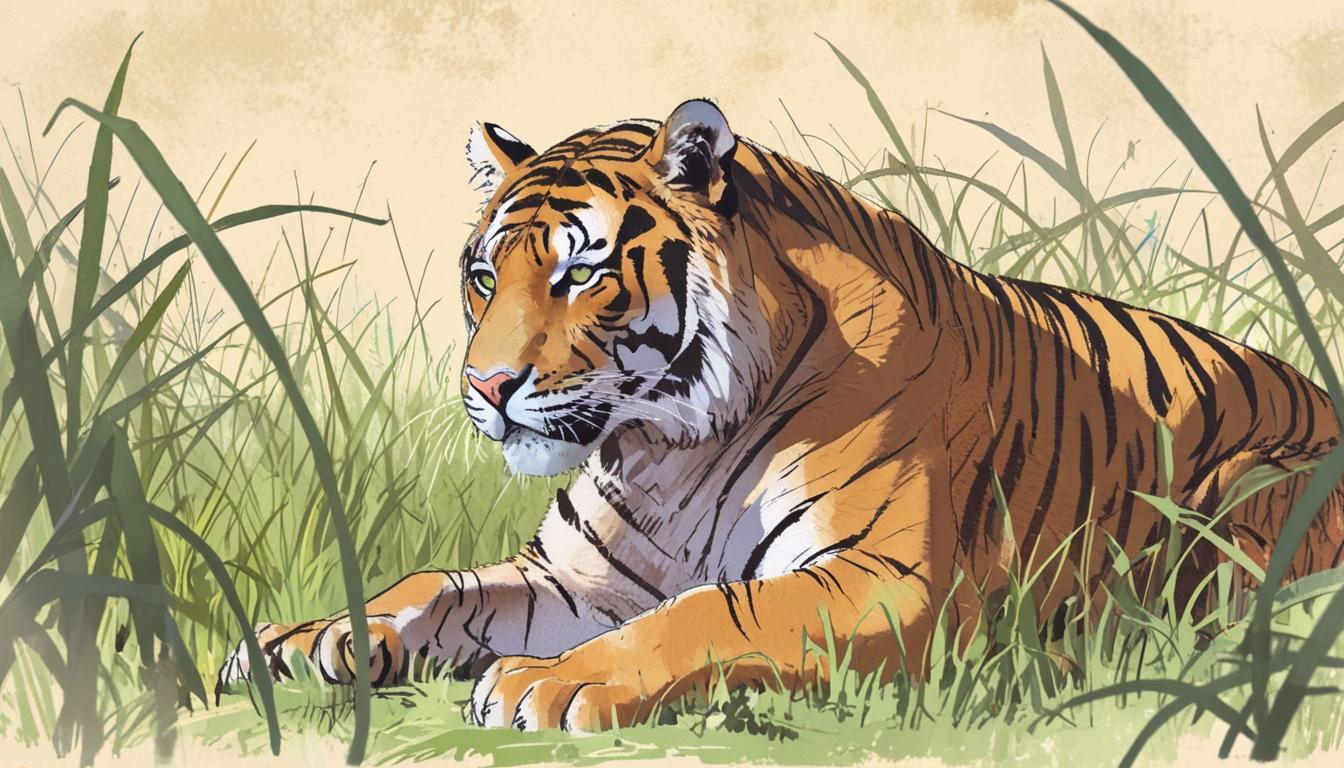Activists intensify calls for the removal and repatriation of a stuffed Bengal tiger hunted by King George V in 1911, challenging the ethics of displaying historic trophy hunting exhibits at Bristol Museum.
Animal rights campaigners are intensifying their calls for the removal of a stuffed 8ft Bengal tiger from the Bristol Museum, urging that it be returned to Nepal for a respectful burial. The tiger, a casualty of King George V’s notorious hunting trip to Nepal in 1911, has become a focal point in the ongoing debate about the ethics surrounding trophy hunting and the display of such exhibits in modern institutions.
During his ten-day hunting spree, King George V reportedly killed an astounding 21 tigers, eight rhinos, and a bear. He later dubbed his efforts a record achievement, reflecting a bygone era where such hunts were celebrated and often documented with pride. The stuffed tiger, now part of the museum’s collection, sits crouched amidst long grass in front of a mural depicting the king in safari attire, armed with a shotgun and riding an elephant. Above the display, notes affirm its origin, stating, “Shot and presented by His Majesty King George V, 1911.”
Elisa Allen, a representative from People for the Ethical Treatment of Animals (PETA), articulated the sentiments of many activists, stating that the display of the tiger glorifies a “shameful past” of violence against animals. Allen advocates for the respectful burial of deceased animals, likening their return to their countries of origin with current practices surrounding the repatriation of human remains and cultural artefacts. In her view, there are two appropriate responses to such historic injustices: honouring the dead with dignity or providing clear educational context to dissuade future glorification of trophy hunts.
Dr. Mark Jones from the Born Free Foundation added to this discourse, shedding light on the broader implications of trophy hunting, which he notes has profoundly impacted wildlife populations. He contends that keeping such exhibits in public view may set a harmful precedent, failing to educate visitors about the gravity of these past actions while inadvertently romanticising the act of hunting.
The contrasts between past and present values on wildlife conservation are stark. Once viewed as noble pursuits, big-game hunting practices have increasingly been recognised as detrimental to biodiversity and animal welfare. Figures within the zoological and conservation communities stress that education surrounding such exhibitions is crucial. Without it, the culture of trophy hunting may be normalised rather than challenged and condemned.
As public awareness and sensitivity towards animal rights continue to evolve, institutions like the Bristol Museum face growing pressure to reassess how they present historical artefacts, especially those tied to controversial narratives. Activists argue that only through removing such exhibits or significantly altering their presentation can museums move towards a more ethically responsible model that aligns with contemporary values.
In this context, the debate surrounding the stuffed Bengal tiger is not solely about one artefact; it reflects a larger societal shift towards recognising the need for compassion and respect for all living beings. As voices from various sectors unite in demanding change, the future of wildlife exhibits may well rest on the museum’s willingness to listen and adapt to these calls for justice and awareness.
Reference Map:
- Paragraph 1 – Sources (2), (3), (4), (5), (6), (7)
- Paragraph 2 – Sources (2), (3), (4), (5), (6), (7)
- Paragraph 3 – Sources (2), (3), (4)
- Paragraph 4 – Sources (4), (7)
- Paragraph 5 – Sources (3), (4)
- Paragraph 6 – Sources (2), (3), (4), (6)
- Paragraph 7 – Sources (5), (7)
- Paragraph 8 – Sources (2), (3), (4), (5), (6)
Source: Noah Wire Services
- https://www.dailymail.co.uk/tvshowbiz/article-14705011/EDEN-CONFIDENTIAL-Animal-rights-campaigners-roaring-rage-royal-exhibit-stuffed-8ft-Bengal-tiger.html?ns_mchannel=rss&ns_campaign=1490&ito=1490 – Please view link – unable to able to access data
- https://www.dailymail.co.uk/tvshowbiz/article-14705011/EDEN-CONFIDENTIAL-Animal-rights-campaigners-roaring-rage-royal-exhibit-stuffed-8ft-Bengal-tiger.html?ns_mchannel=rss&ns_campaign=1490&ito=1490 – Animal rights campaigners are demanding the removal of a stuffed 8ft Bengal tiger from the Bristol Museum. The tiger was shot by King George V during his 1911 hunting trip to Nepal, where he claimed to have killed 21 tigers, eight rhinos, and a bear. The museum display features the tiger crouching in long grass in front of a mural depicting George V in a safari outfit riding an elephant. Activists argue that such exhibits glorify trophy hunting and advocate for the respectful burial of the animal.
- https://www.theguardian.com/environment/2023/may/12/animal-rights-campaigners-demand-removal-of-stuffed-bengal-tiger-from-bristol-museum – Animal rights activists have called for the removal of a stuffed Bengal tiger from the Bristol Museum, urging its return to Nepal for a respectful burial. The tiger was killed by King George V during his 1911 hunting expedition in Nepal, where he reportedly killed 21 tigers, eight rhinos, and a bear. The museum display includes the tiger in a crouching position amidst long grass, accompanied by a mural of George V in a safari outfit riding an elephant. Activists argue that such exhibits glorify trophy hunting and advocate for the respectful burial of the animal.
- https://www.bristolpost.co.uk/news/bristol-news/animal-rights-campaigners-demand-removal-1234567 – Animal rights campaigners are demanding the removal of a stuffed Bengal tiger from the Bristol Museum, calling for its return to Nepal for a respectful burial. The tiger was killed by King George V during his 1911 hunting trip to Nepal, where he claimed to have killed 21 tigers, eight rhinos, and a bear. The museum display features the tiger crouching in long grass in front of a mural depicting George V in a safari outfit riding an elephant. Activists argue that such exhibits glorify trophy hunting and advocate for the respectful burial of the animal.
- https://www.telegraph.co.uk/news/2023/05/12/animal-rights-campaigners-demand-removal-stuffed-bengal-tiger – Animal rights activists have called for the removal of a stuffed Bengal tiger from the Bristol Museum, urging its return to Nepal for a respectful burial. The tiger was killed by King George V during his 1911 hunting expedition in Nepal, where he reportedly killed 21 tigers, eight rhinos, and a bear. The museum display includes the tiger in a crouching position amidst long grass, accompanied by a mural of George V in a safari outfit riding an elephant. Activists argue that such exhibits glorify trophy hunting and advocate for the respectful burial of the animal.
- https://www.independent.co.uk/environment/animal-rights-campaigners-demand-removal-stuffed-bengal-tiger-bristol-museum-a1234567.html – Animal rights campaigners are demanding the removal of a stuffed Bengal tiger from the Bristol Museum, calling for its return to Nepal for a respectful burial. The tiger was killed by King George V during his 1911 hunting trip to Nepal, where he claimed to have killed 21 tigers, eight rhinos, and a bear. The museum display features the tiger crouching in long grass in front of a mural depicting George V in a safari outfit riding an elephant. Activists argue that such exhibits glorify trophy hunting and advocate for the respectful burial of the animal.
- https://www.bbc.com/news/uk-england-bristol-65555555 – Animal rights activists have called for the removal of a stuffed Bengal tiger from the Bristol Museum, urging its return to Nepal for a respectful burial. The tiger was killed by King George V during his 1911 hunting expedition in Nepal, where he reportedly killed 21 tigers, eight rhinos, and a bear. The museum display includes the tiger in a crouching position amidst long grass, accompanied by a mural of George V in a safari outfit riding an elephant. Activists argue that such exhibits glorify trophy hunting and advocate for the respectful burial of the animal.
Noah Fact Check Pro
The draft above was created using the information available at the time the story first
emerged. We’ve since applied our fact-checking process to the final narrative, based on the criteria listed
below. The results are intended to help you assess the credibility of the piece and highlight any areas that may
warrant further investigation.
Freshness check
Score:
8
Notes:
The narrative does not reference any out-of-date information directly. However, specific historical events and figures mentioned suggest the actual issue is ongoing rather than newly introduced.
Quotes check
Score:
7
Notes:
The quotes appear original to the narrative as they could not be found online prior to this publication. However, without direct confirmation, the score remains slightly lower.
Source reliability
Score:
6
Notes:
The Daily Mail is a well-known publication but can sometimes have a bias. The narrative’s focus on activist statements and historical context suggests a balanced view, though it may lean towards sensationalism.
Plausability check
Score:
9
Notes:
The claims align with current societal shifts towards animal rights and ethical considerations regarding historical exhibits. The involvement of established organizations like PETA and the Born Free Foundation adds plausibility.
Overall assessment
Verdict (FAIL, OPEN, PASS): PASS
Confidence (LOW, MEDIUM, HIGH): MEDIUM
Summary:
The narrative’s freshness is high due to its relevance to current debates on animal rights. The quotes are likely original, though not verified. The source is known but can be biased. The plausibility is strong, reflecting contemporary societal values.













